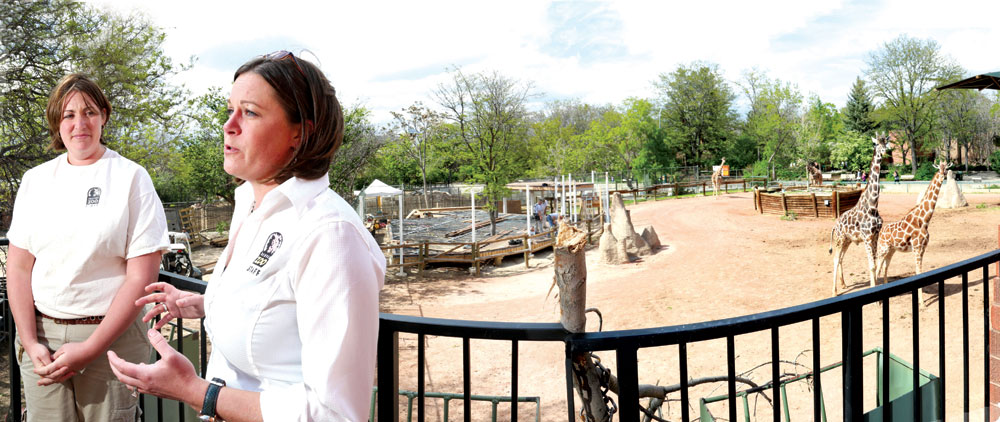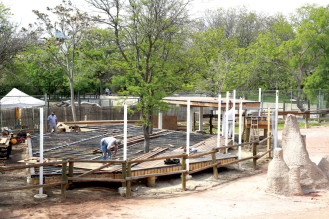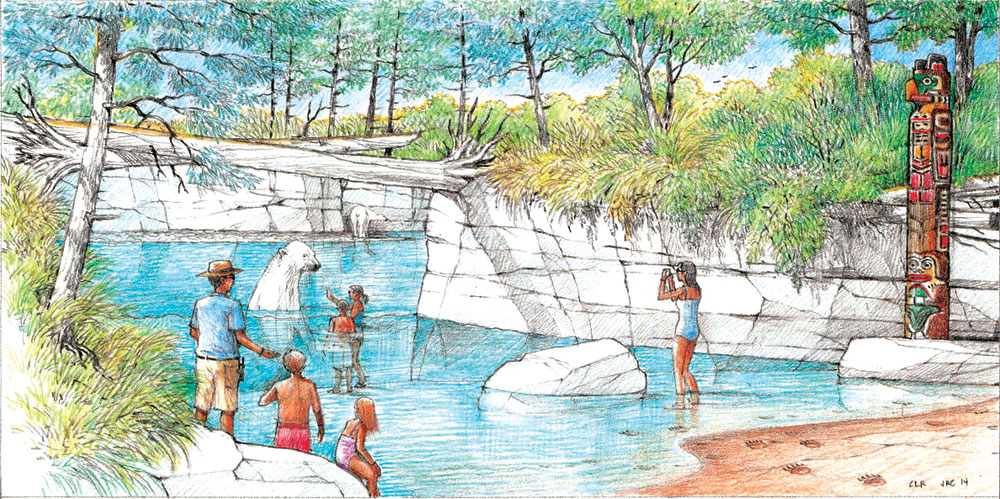
Loren Berry, zookeeper, (left) and Brittany Frederick, Guest Engagement Manager, (right) describe the Giraffe Encounter where visitors will be able to feed giraffes from a platform. Construction is underway (shown below) and it is expected to open in late June.
 Imagine the Denver Zoo and what would make it a better experience. Most likely, some of the things that come to mind are included in the Master Revision Plan that was released in May.
Imagine the Denver Zoo and what would make it a better experience. Most likely, some of the things that come to mind are included in the Master Revision Plan that was released in May.
This massive 15-year plan identifies everything that needs improvement and dreams up new guest experiences. “There are a number of different things we’ve unveiled, like swimming with polar bears or being up in a tree house looking over the African savannah, that we think create really unique experiences moving forward,” says George Pond, vice president for design and campus management at Denver Zoo. Yes, he did say swimming with polar bears (more information below).
From 2010 to 2012, the Denver Zoo Planning Department performed a Facility Assessment to evaluate the state of the zoo. The assessment revealed the zoo has several outdated buildings in need of repair. The plan removes these buildings and adds new ones, without taking up any new space. The largest building will be a Waste Management Building, which is part of the zoo’s goal for zero waste by 2025.
The facility assessment also revealed certain areas of the zoo are confusing to navigate or over-congested with people, so the plan proposes new walkways for a more natural flow. It also adds a “Braided Path,” or a trail that diverges from the main path for kids to explore and get a closer view of animals.
Currently, as part of the master plan, the zoo is constructing Giraffe Encounter, where from 10am to 4pm daily visitors can purchase a token to walk up a platform by the giraffe yard and feed lettuce to giraffes Dikembe, Kipele, Masika and Heshimu. At the Giraffe Encounter, volunteers and employees will give educational talks.
“By educating and engaging people at the zoo, we believe it secures a better future for animals,” Pond says. Striking the right balance between guest experience and animal health and well-being is not difficult because it all falls under the one goal of securing a better future for animals, according to Pond.
“Even if people leave just knowing the names of the giraffes, they’ll go home and talk about it with their friends, and beyond that we hope people will learn why giraffes are important,” says Brittany Frederick, who works in the education department at the zoo.
Giraffe Encounter is expected to open in late June (the exact date is not determined). Also part of the master plan, several other exhibits have been proposed for the coming years, including:
Asian Highlands & Asian Predators: This exhibit will feature temperate Asian species, or animals that can endure cold weather. Possible species to be added include the Amur tiger, snow leopard, Amur leopard, takin, Prezwalski’s horse, Pallas’ cat, Bactrian camel, sloth, cinereous vulture, bustards and cranes.
Africa: A Wild Savannah: This exhibit will add baobab trees, which are native to Africa and resemble tall broccoli. The exhibit will also have an outdoor theater for animal encounters. Black rhinoceros, giraffe, Grevy’s zebra, gerenuk, okapi, bongo, ground hornbills, storks, vultures, waterfowl and cranes may potentially be added.
Africa: The Watering Hole: A new restaurant called The Watering Hole will replace the zoo’s current restaurant and grille and will be located in a more accessible area of the zoo for visitors.
Africa: The West Portal: The portal will be dedicated to education and located at the west end of the parking garage. People will be able to look down on the African savanna exhibit from a tree house. There will be public shows and presentations. The lower level will house a science lab for middle, high school and college students.

The proposed Polar Bear Encounter at the Coastal Exhibit would allow people swim in a shallow pool and view polar bears underwater (separated by a glass wall). Rendering provided by Denver Zoo.
Coastal: At the coastal exhibit, visitors will learn how animals adapt to changing ecosystems and harsh conditions, and feature polar bears. A glass wall will separate the polar bear tank from a shallow pool where people will be able to swim and view the animals underwater (see rendering). Polar bears, sea lions, harbor seals and Stellar’s sea eagles are proposed for this exhibit.
Coastal: The East Portal: This area will be for special events and feature an underwater walkway. Proposed species include salmon, trout, Arctic char, eel, catfish and crayfish.
The Denver Zoo is currently prioritizing which part of the plan to do first, and seeking funds through fundraisers and donors. To learn more about the upcoming changes, visit http://www.denverzoo.org/master-plan.
What Else is Happening at Denver Zoo This Summer?
Be a Zookeeper Zone: Kids ages 2-10 and their adults can learn about being a zookeeper in three different exhibits
Nature Connects, Art with LEGO Bricks: Starting August 7, life-size animal and plant sculptures made out of LEGO bricks will be scattered throughout the zoo.
Penguin Encounter: See how zookeepers prepare food and care for the penguins in a guided tour. At the end, visitors will be able to interact with penguins.
Great Apes Encounter: This walking history of Denver Zoo ends at the great apes exhibit where zookeepers will discuss working with the animals. The tour gives access to a rooftop view of the orangutans and gorillas.
Tropical Discovery Meet and Greet: This tour allows access to behind-the-scenes of the Tropical Discovery exhibit that houses rainforest species.
Backstage Experience: This 3-hour guided tour involves more close-up interaction with animals, like touching turtles. It ends with front-row seats at the summer Wildlife Show.
Backstage Experience Junior: This is very similar to the Backstage Experience, but only 90 minutes and geared toward younger children.



0 Comments